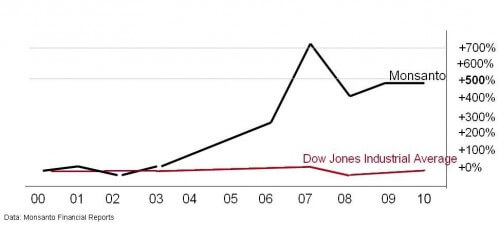In this article we will examine the level of danger inherent in genetically modified plants according to three main categories

Recently, differences of opinion emerged between me and the Greenpeace organization, which were expressed in an article published in the "other science" blog And in the reactions (some angry, most milder) that try to present the genetically modified plants as having inherent dangers, and the biotech companies that produce them as greedy and only interested in money.
It's hard to argue with at least one part of the argument: biotech companies, like Monsanto, have deservedly earned their reputation. It is clear to everyone that they strive to make money. This is the essence of the capitalist economy - the companies have to make money, for the benefit of their shareholders. A company on the stock exchange has no right to reduce its profits, without a good excuse. In fact, during a certain period of the American economy, the shareholders of Ford sued the owner of the company for deciding to help the ordinary workers - at the expense of the profits of the shareholders. We can love the capitalist economy or hate it, but the companies themselves must compete to show profits, and that's fine.

What else? In the mad pursuit of money, the companies may also release to the market products that do not meet the safety rules. Because of this, government bodies such as the US Food and Drug Administration, are obliged to stand guard and make sure that the products are not harmful.
But how do you know if the genetically modified plants are dangerous? Are the genetically modified plants dangerous to health?
It is important to clarify that 'genetically modified plants' is only a general name for a very large group of plants, into each of which one or more genes have been inserted that give the plant a new feature. Some (like NK603) gain resistance to insecticides or herbicides. Others, like MON 863, are able to produce a new toxin that harms primitive creatures such as insects and worms that wish to feast on the fruits of the farmer's labor. And of course, in the laboratories there are also more 'sophisticated' plants, engineered so that their properties are adapted to the consumer's wishes: they can be bigger or smaller, come in different colors, or grow in dry and humid conditions that would kill any normal plant.
It is clear that all genetically modified plants cannot be treated as if they all had the same level of risk. Instinctively we understand that the plants that have been engineered to produce toxins against insects may carry a greater danger than the plants that have been engineered to grow in dry conditions. Each variety of genetically modified plant is different from the others, and there is no point in putting them all under the same general and inclusive category.
Despite the need to differentiate between each type of genetically modified plant, a large number of green organizations categorize all genetically modified plants as a health hazard, and insist on treating them as such until proven otherwise. At this point it is important to clarify that a genetically modified plant has never been discovered that was grown and sold on a commercial scale and was poisonous to humans. Until 1998, genetically modified plants were grown in the United States, Great Britain and other countries without encountering the kind of opposition that exists against them today. Certain brands of ketchup, for example, were produced at the time from genetically modified tomatoes and were labeled accordingly in stores. And the public bought, and was satisfied.
The revolution began in 1998, when a scientist named Dr. Poztai announced on television that genetically modified potatoes are toxic to rats and damage their nervous system. The public in England in particular, which had remained alarmed by the outbreak of mad cow disease two years earlier, shunned the genetically modified plants, and the media continued to increase the hype. And from then until today, we are in the age of fear.
Are the genetically modified plants really harmful by nature? Is there a basis for fear? To answer the question, we must review the various studies conducted on a large variety of genetically modified plants, and try to identify whether they are harmful to diners. Since international conventions prohibit us from conducting these experiments on humans, we will have to make do with our distant relatives - the rats and mice.
We will examine the level of danger inherent in genetically modified plants according to three main categories, each of which will have its own record. And these are –
- Are the genetically modified plants toxic to humans or mammals?
- Are the genetically modified plants allergenic (causing allergies) or cause other long-term damage?
- Do the genetically engineered plants harm the environment?
Explanation about toxicity studies
In the current entry I chose to focus on the first question: the question of toxicity.
In the current decade, many studies have been conducted around genetically modified plants. In order to confirm their nature, I am detailing in this record the results of the most comprehensive, most recent and balanced review I could find, which was published in 2011 in the scientific journal Environment International. The authors review dozens of previous studies that examined the potential toxicity of genetically modified plants. They focus on three types of plants in particular, because the vast majority of research is done on them: corn, soybeans, and rice.
Most of the reviewed studies were carried out by feeding rats with genetically modified food, and monitoring their general health for ninety days. At the end of the experiments, the rats were usually sacrificed for the sake of science, and their internal organs were carefully examined to assess their condition. Some of the researchers delved into the animals so much that they took the cells from the liver, kidneys and other tissues and checked their condition. In short, there was a real experience here as well as to examine the effect of genetically modified food on complex mammals such as rats.
Why did the experiments last only ninety days usually? Because toxicity manifests itself in a relatively immediate effect. If you drink poison, God forbid, within a few hours your body cells will already react to the harmful substance. If you drink it in low doses, you may not get an immediate reaction - but after a few weeks, the cells in the liver will begin to collapse under the cumulative load, the kidneys will fail to fulfill their role, the brain will suffer cumulative damage, and so on. Because of this, ninety days should be more than enough to notice the effects of a toxic substance, even in very low doses.

And what were the results?
As expected in a field where there are many different criteria for success, very different results were obtained for some of the experiments - some of which indicate a complete lack of effect of the genetically modified food on health, and others suggest a toxic effect.
Two studies in particular caught my attention. One was done on mice injected with MON 863 - corn whose cells produce a poison against worms. It is important to say that the mere fact that the cells produce 'poison' does not immediately mean that there is a danger to humans. Many plants - from the noble lettuce to the ragged mint - produce toxins against the animals that strive to eat them. MON-863 corn has been engineered to produce an anthelmintic toxin that should not affect humans or mammals in general. Despite this, the rats that ate the corn for ninety days lost approximately 3% of their weight, and showed signs of liver and kidney disease - the type usually known from eating toxic substances.
Scary? very And so a panel of experts was convened who went over the research and raised eyebrows in wonder. We expect a toxic substance to cause more harm when given in higher doses. Corn MON-863 did not cause more damage to the rats, even at the highest doses. This strange fact, as well as other problems in the researchers' analysis, led the panel to conclude that the results of the analysis do not indicate the toxicity of MON-863 corn.
The original group of researchers did not give up, and published another study in 2009 that produced alarming results. Rats were fed three types of genetically modified plants: NK-603, MON-810, MON-863. Signs of poisoning were discovered in the rats - and this is indeed worrying, especially due to the fact that the research seems 'kosher'. Unfortunately, it only lasted ninety days, and took place over three years ago. Hence the question is raised, also in the review itself, why the researchers have not since published the results of other similar longer-term studies. As the authors of the review put it themselves - "It seems unbelievable that the risk assessment... was not restored and extended indefinitely."
Or, in other words, something still stinks in this study as well.
Are you starting to bang your head against the wall? Welcome to the wonderful world of science, where a large number of studies need to be examined carefully and meticulously in order to begin to form a more complete picture of the world. And since there are always researchers who conduct bad studies, who cheat on the results and who are biased by favors or money, it is important to look at all the studies and not concentrate on just one.
Until now I have written about the studies that indicate the toxicity of genetically modified corn, especially the MON-863 type. There were two such studies. This. Only two, out of 17 studies that have taken place in the last five years on genetically modified corn. All the other 15 studies ended with a clear statement that the genetically modified corn is not dangerous to health.
Want more? 13 Similar toxicity studies were also conducted in rice and soybeans. Of these, only one showed a strange physiological phenomenon: the lymph nodes of the rats that received one of the types of genetically engineered rice, swelled. Not exactly toxicity, but still noteworthy. In all other 12 studies no negative health effects were detected.
I took the liberty of presenting the studies in one large table. Each square represents a different study. The squares in red represent studies in which the genetically modified food had a toxic effect. The squares in green - studies in which the genetically modified food did not harm the body. The end result looks like this:
I think the point is clear: out of 30 studies that tried to check whether genetically modified food is toxic, only two determined that it is - and their claims are also questionable, and come from the same research group. These are the beautiful results of dozens of scientific studies that join together in the same statement: genetically modified food is not toxic!
Yet…
Are you convinced that genetically modified food is completely safe? Nice - maybe you can also reassure me, because I'm still not completely convinced.
First of all, a large part of the research I presented is funded by various biotechnology companies, including our old friend Monsanto. Funded studies tend to have results consistent with the funding source. This fact impairs the strength of the studies, but does not eliminate them completely. Many researchers were endowed with the necessary internal honesty to publish results that are not in line with the financier's ambitions, and in any case - some of the studies on the list were not supported by the biotech companies, and still came to the conclusion that the genetically engineered plants are not toxic.
At this point you may decide that all the studies are worth nothing, because they are all funded or motivated by personal interests - including those that showed that the plants are actually poisonous! There is some truth in this, but history teaches us that in controversial issues, within a few years the truth comes to light and a scientific consensus is formed. The scientific community is like a sand sieve, which undergoes constant shaking. Through the holes fall the studies that are too small, too crude, or that are not done according to the rules. In the end, a number of gold particles will be left - and these are the most reliable and serious studies, which provide the results you can trust. As of this moment, the gold studies prove that genetically modified plants are not poisonous by nature.
This statement does not mean that we can rest our guard and stop testing the toxicity of new transgenic plants. A hypothetical situation is certainly possible in which chlomial genetic engineers inject the plant with instructions that cause it to produce a new and toxic protein. This means that we, the consumer audience, should demand that every new plant that enters the market pass a number of basic toxicity tests, before it is used for human consumption. I would like to see the green organizations promote this demand, instead of religiously avoiding almost any type of genetically modified food.
The overview I have presented so far serves mainly to provide one clear statement: genetic engineering in itself is not a factor that gives plants toxicity. And that's important too. In the end, there is no immediate health reason to be overwhelmingly opposed to genetically modified plants.

In the next episode…
Even if genetically modified plants are not toxic, they may have longer-term health effects, or be more allergenic (allergy-causing) than conventional plants. They may even have devastating effects on the environment. We will deal with these topics in the next entries in the series, and at the end we will also explain the motives behind the use of genetically modified plants.
Transgenic plants - the fear and the necessity. Avi Blizovsky, from Galileo

6 תגובות
I don't think that's the intention. This is a standard period of time for toxicity studies (90 days) which he refers to as sufficient when the studies show no harm and not sufficient when the studies show that there is harm.
And here's something else jarring:
Of all the studies that did not find a problem with transgenic food (15) - how many of them were funded by the industry? How many have inadequate samples or inherent biases? Meta-analyses, for example, tend to be greatly influenced by the quality of the studies they have scanned - where is this matter addressed here?
It may be that these two studies that found a problem with transgenic food are more reflective of reality than the other 15 studies that did not find a problem.
We will wait for explanations, if any.
According to my understanding, he meant that the research ended two years and nine months ago.
Other than that, thanks for the article, very interesting
The writer's position regarding the duration of toxicity experiments is not clear - he expresses a contradictory position:
On the one hand:
"Why did the experiments last only ninety days usually? Because toxicity manifests itself in an immediate effect" he points out that this is how all the studies in the field were done.
On the other hand, regarding the study that did find harm to mammals from transgenic food (NK-603, MON-810, MON-863), he writes:
"Unfortunately, it only lasted ninety days, and took place more than three years ago. Hence the question is raised, also in the review itself, why the researchers have not since published the results of other similar, longer-term studies."
So is a 30 day toxicity study enough or not?
Perhaps this is only sufficient for studies that do not find harm - because this is the position the author of the article clearly supports...
Where is the summary table? Very intriguing but not found in the article